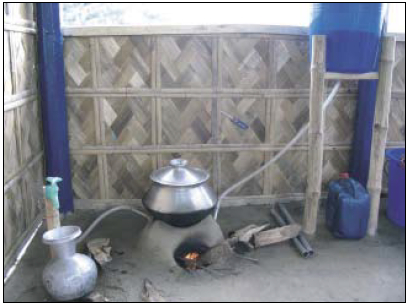Difference between revisions of "Chulli pasteurization"
From Akvopedia
(Created page with "Chulli pasteurization. <br>Photo: Johnston, UNICEF.") |
|||
| Line 1: | Line 1: | ||
[[Image:chulli pasteurization.jpg|thumb|right|300px|Chulli pasteurization. <br>Photo: Johnston, UNICEF.]] | [[Image:chulli pasteurization.jpg|thumb|right|300px|Chulli pasteurization. <br>Photo: Johnston, UNICEF.]] | ||
| + | |||
| + | Pasteurization is the process of disinfecting water by heat or radiation. Typical water pasteurization achieves the same effect as boiling, but at a lower temperature (usually 65-75°C), over a longer period of time. | ||
| + | |||
| + | The chulli stove system combines two water treatment processes: filtration and pasteurization. Water flows first through a rapid sand filter and then into aluminium tubing coiled inside a traditional clay stove (chulli). From the stove, the water flows through heat resistant plastic tubing to an outlet tap, where it is collected in a container. | ||
| + | |||
| + | The water is pasteurized during daily cooking. By regulating the flow, the water temperature can be maintained at 70°C; sufficient for pasteurization as it flows through the coil. | ||
| + | |||
| + | |||
| + | ==Acknowledgements== | ||
| + | * [http://www.google.com/url?sa=t&rct=j&q=&esrc=s&source=web&cd=1&ved=0CGcQFjAA&url=http%3A%2F%2Fappropriatetechnology.wikispaces.com%2Ffile%2Fview%2FHWTS%2BFact%2BSheet_Simplified_Chulli%2BPasteurization_Jul%2B09.pdf&ei=7Ue1T9WpFcWViAKVmZ26Ag&usg=AFQjCNGIgJ-EeVNOzYLIHINvoXnF2FvCyg&sig2=QbnGL5VVMt3Nlh5DsaxxWA Household Water Treatment and Safe Storage Fact Sheet: Chulli Pasteurization.] CAWST, 2009. | ||
Revision as of 20:49, 17 May 2012
Pasteurization is the process of disinfecting water by heat or radiation. Typical water pasteurization achieves the same effect as boiling, but at a lower temperature (usually 65-75°C), over a longer period of time.
The chulli stove system combines two water treatment processes: filtration and pasteurization. Water flows first through a rapid sand filter and then into aluminium tubing coiled inside a traditional clay stove (chulli). From the stove, the water flows through heat resistant plastic tubing to an outlet tap, where it is collected in a container.
The water is pasteurized during daily cooking. By regulating the flow, the water temperature can be maintained at 70°C; sufficient for pasteurization as it flows through the coil.

